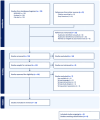Systematic review of the impact of ginger extract and alpinetin on pregnancy outcomes in animal models
- PMID: 40380319
- PMCID: PMC12083149
- DOI: 10.1186/s12906-025-04904-z
Systematic review of the impact of ginger extract and alpinetin on pregnancy outcomes in animal models
Abstract
Background: The objective of this systematic review was to evaluate existing scientific evidence regarding the effectiveness and safety of preparations of bioactive compounds of the Zingiberaceae family in animal models during gestation and lactation.
Methods: A systematic protocol was registered with the Open Science Framework (OSF) ( https://doi.org/10.17605/OSF.IO/ADU68 ). The literature search was conducted on selected databases such as MEDLINE, Embase, Center for Agricultural and Biosciences International, and the International Pharmaceutical Abstracts databases. The full search strategy is included in the Supplementary Materials. Main keywords related to population included terms related to pregnancy and lactation; keywords related to intervention included key terms for alpinetin, ginger, and Zingiberaceae plants. We included maternal (i.e., dam) and neonatal (i.e., pup) outcome(s) reported in studies with ginger preparations in various forms given during pregnancy or lactation compared to placebo. Risk of bias was assessed using the Systematic Review Center for Laboratory animal experimentation (SYRCLE) risk of bias tool.
Results: Twelve studies published between 2000 and 2022 were included in the review. Ginger and its bioactive compounds, [6]-gingerol, [8]-gingerol, [10]-gingerol, and [6]-shogaol, were found to have protective effects against gestational and developmental toxicities. This included mitigating and preventing organ toxicity (e.g., liver and kidney), improved gestational weight gain, and improved placental function; fetal benefits included prevention of organ damage (e.g., liver, kidney, cardiac), improved fetal growth, reduced oxidative stress, and reduced death. In studies involving toxic exposures such as heavy metals and pesticides, ginger mitigated adverse effects on maternal and fetal health, improving outcomes such as placental function birth weight, and organ development (e.g., liver, kidney, cardiac). Alpinetin, a flavonoid rich in ginger plants, showed anti-inflammatory effects in lactation by reducing cytokine levels and improving mammary tissue health. Studies on fetal development reported improvements in birth weight, growth metrics, and reductions in death rates when ginger was administered at moderate doses, specifically ginger tea 20 g/L-50 g/L or gingerol 25 mg/kg/body weight. However, higher doses (specifically, 50 mg alligator pepper, 2,000 mg/kg body weight Zingiber officinale) caused adverse reproductive outcomes such as reduced weight gain (< 50%), maternal toxicity, disrupted estrous cycle, and increased fetal death. Sensitivity analysis confirmed that lower dosages of rhizome-derived ginger preparations (Zingiber officinale) (< 200 mg/kg/day) were safer.
Conclusion: The majority of the included studies reported protective effects of lower dose Zingiberaceae preparations (< 200 mg/kg/day) on gestational and developmental toxicities in animal models. Standardization of ginger interventions and more robust study designs are needed to optimize ginger form, amounts, preparation, doses, and timing of exposures to understand how maximize benefits while minimizing potential adverse effects in animal models before such data can be translated meaningfully to humans.
Clinical trial number: Not applicable.
Keywords: Animal; Ginger; Ginger extract; Lactation; Pregnancy.
© 2025. The Author(s).
Conflict of interest statement
Declarations. Ethics approval and consent to participate: Not applicable. Consent for publication: Not applicable. Competing interests: The authors declare no competing interests.
Figures


Similar articles
-
The Use of Ginger Bioactive Compounds in Pregnancy: An Evidence Scan and Umbrella Review of Existing Meta-Analyses.Adv Nutr. 2024 Nov;15(11):100308. doi: 10.1016/j.advnut.2024.100308. Epub 2024 Sep 28. Adv Nutr. 2024. PMID: 39343171 Free PMC article. Review.
-
Promotion of Mitochondrial Biogenesis via Activation of AMPK-PGC1ɑ Signaling Pathway by Ginger (Zingiber officinale Roscoe) Extract, and Its Major Active Component 6-Gingerol.J Food Sci. 2019 Aug;84(8):2101-2111. doi: 10.1111/1750-3841.14723. Epub 2019 Aug 1. J Food Sci. 2019. PMID: 31369153
-
Therapeutic effects and mechanisms of action of ginger and its bioactive components on inflammatory response, oxidative stress, the immune system, and organ failure in sepsis: a comprehensive systematic review.Nutr Rev. 2024 Dec 1;82(12):1800-1819. doi: 10.1093/nutrit/nuad156. Nutr Rev. 2024. PMID: 38102801
-
Larvicidal constituents of Zingiber officinale (ginger) against Anisakis simplex.Planta Med. 2010 Nov;76(16):1852-8. doi: 10.1055/s-0030-1249971. Epub 2010 Jun 8. Planta Med. 2010. PMID: 20533167
-
Protective and therapeutic potential of ginger (Zingiber officinale) extract and [6]-gingerol in cancer: A comprehensive review.Phytother Res. 2018 Oct;32(10):1885-1907. doi: 10.1002/ptr.6134. Epub 2018 Jul 16. Phytother Res. 2018. PMID: 30009484 Review.
References
-
- Mao QQ, Xu XY, Cao SY, Gan RY, Corke H, Beta T et al. Bioactive Compounds and Bioactivities of Ginger (Zingiber officinale Roscoe). Foods [Internet]. 2019 May 30 [cited 2024 Aug 15];8(6):185. Available from: https://www.mdpi.com/2304-8158/8/6/185 - PMC - PubMed
-
- Balubaid SOAB. Therapeutic effect of ginger against the tetracycline adverse effects on mother and embryos liver of albino rats. 2010 [cited 2024 Aug 26]; Available from: https://www.cabidigitallibrary.org/doi/full/10.5555/20113072563 - DOI
-
- Shireen PA, Muraleedharan K, Abdul Mujeeb VM. Theoretical studies on anti-oxidant potential of alpinetin. Mater Today Proc [Internet]. 2018 Jan 1 [cited 2024 Oct 1];5(2, Part 3):8908–15. Available from: https://www.sciencedirect.com/science/article/pii/S2214785317333278
Publication types
MeSH terms
Substances
Grants and funding
LinkOut - more resources
Full Text Sources
Research Materials

